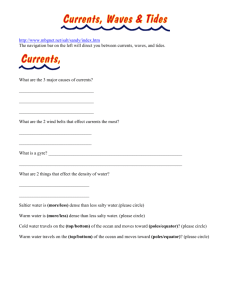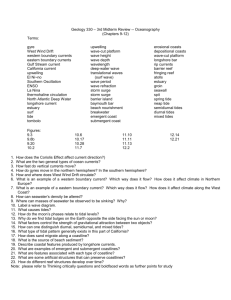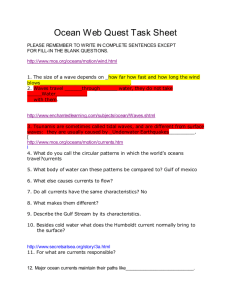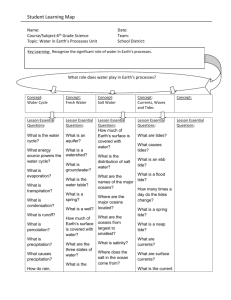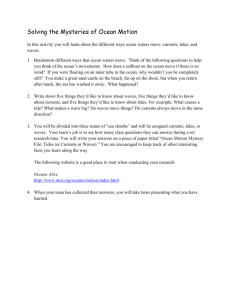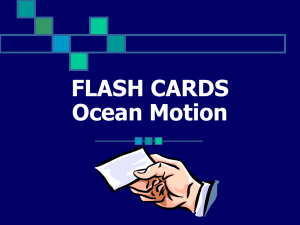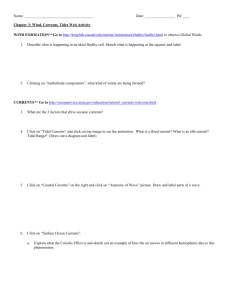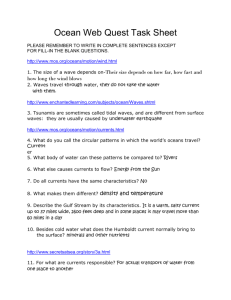Slideshow
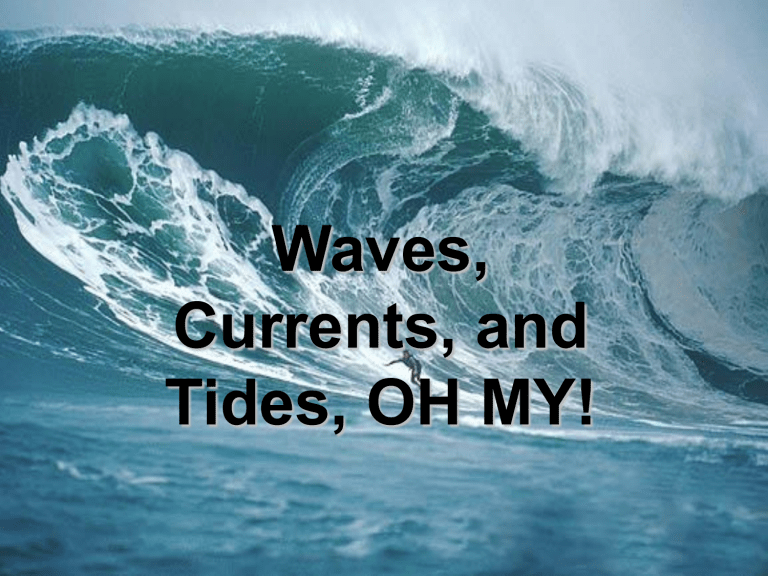
Waves, Currents, and Tides,
Waves,
Currents, and
Tides, OH MY!
DO NOW – hw due Friday!
1. What percent of the water on Earth is good for drinking?
2. Where does the salt in the oceans come from?
3. What is the difference between the continental shelf and the continental slope?
4. What is echo sounding?
5. Does water actually move in a wave?
What are we learning about?
Ways the Ocean can Move
• This week is about the motion in the ocean
• Waves , Currents and Tides are all connected because they are different ways that the ocean can move!
TIDES!
Inquiry
&
Brain Pop
• What did you notice about the two pictures above?
• What is different about them?
• Why do you think that difference occurs? What do you think this picture has to do with tides?
http://www.brainpop.com/science/earthsystem/tides/
Listen and Learn
• www.brainpop.com/science/earthsystem/tides
• Questions to answer during video: (copy down what is in red)
• 1. What causes Tides?
• 2. The moon is smaller than the sun. Why does it still have a big effect of the Earth’s oceans?
• 3. How many high tides and how many low tides do most places get each day?
• 4. How can tides be useful?
What are Tides?
• A tide is the daily rise and fall of the ocean ’ s surface
• It happens because of the gravitational pull of the moon on the earth and earth’s oceans http://oceanservice.noaa.gov/education/kits
/tides/media/supp_tide01.html
How often do they happen?
• Tides happen every 12 • Check for
HOURS
Understanding!
– They repeat in a regular pattern because of the rotation of the earth every
24 hours.
• If it is high tide at
4:00pm, when
• So if you have a low tide will the next high at 7am you will have another low tide 12 tide occur? hours later at 7pm!
The Battle of the Bulge something that gets bigger or swells up.. Like your backpack when its full of books!
• The moon’s gravity PULLS the ocean towards it!
• The parts of the ocean that are directly facing AND opposite to the moon start to bulge out (get bigger)
• These bulges are called high tides
• Where ever there is no bulge and the ocean water is low is low tide.
Why are there two high tides??
BUT the gravitational pull of the moon also attracts the
Earth!!
So, we always have two high tides and two low tides
Low Tide
High Tide
Low Tide
High Tide
Check for Understanding
Moon • In the picture to the left, where are high tide and low tide happening?
Earth
Watch as the Bulge Follows the moon!
• Where do you always see the bulge forming?
– http://aspire.cosmicray.org/labs/tides/tides_main.html
• Student Demo: Creating a Tide
Two special types of tides:
Spring and Neap Tides
• Spring Tides:
– Occur when the sun, moon, & earth are in a line (so during full moons and new moons)
– Gravitational pull is REALLY strong because pull of the sun and moon are combined.
– The high tides are very high and the low tides are very low . (you get extreme high and low tides)
Spring and Neap Tides
• Neap Tides:
– Occur when the sun, moon & earth make a 90 degree angle ( or “ L ” shape)
• So they happen during
Occur during quarter moon phases
– Gravitational pull of the moon and sun almost cancel each other out
– Result: very little difference between high & low tides.
high and low tides look alike!
All in a straight line
= Spring tide
In an “L” shape =
Neap tide
Check for Understanding: Spring and Neap Tide Diagram
Final Diagram
Put it all together!
Review
• 1. What causes tides??
• 2. What is the difference between a neap tide and a spring tide?
• 3. If you have a high tide at 3:00pm, when will the next high tide occur?
Tides Day 2
Lab and Foldable
DO NOW – hw due Friday
• 1. What causes tides?
• 2. How often do tides occur?
• 3. When the sun, earth, and moon are in a straight line, will we get a spring tide or a neap tide? What about when they are in an “L” shape?
• 4. You want to go swimming when the tide is low tomorrow. You know that low tide tonight is at 8:00PM. What time should you go swimming tomorrow to catch the low tide?
Lab: Making your Own Tides
• Follow along with the lab sheet to use the materials at your desk to create your own tides.
Lab: Make your own tides
• 1. Use the plate and circular piece of string at your desks to create the earth and the outline of the oceans. Pick another object at your desk to represent the moon.
• 2. Just as you saw in the demo, create a high and a low tide using the earth, the ocean outline, and the moon.
Lab: Make your own tides
• 1. What does your plate represent?
• 2. What does the string represent?
• 3. The string will be pulled toward the moon and bulge.
– a. The earth itself will also be pulled toward the moon because of gravity!
• 4. High tide happens on the side of the earth closest to the moon
AND on the opposite side.
• 5. Low tide happens in between the areas of high tide.
Lab: Make your own tides
• 1. What does your plate represent?
• 2. What does the string represent?
• 3. What will happen to the string on the side of the earth where the moon is? The string will be pulled toward the moon and bulge.
• 4. What will happen to the earth after the moon’s gravity pulls on the oceans? The earth itself will also be pulled toward the moon because of gravity!
• 5. Another bulge will be left on the opposite side of the first one!
Lab: Make your own tides
• 6. What will change as the earth makes its daily rotation on its axis?
• 7. The moon causes tides because of its gravitational pull on the earth. Gravity between the earth and the moon pulls the oceans towards the moon.
Tides Foldable
Exit Ticket
Currents
DO NOW – hw is due Friday
1.What causes tides?
2.When are tides at their highest level?
3.Explain the difference between a spring tide and neap tide.
4. Where does the salt in the ocean come from?
5. If you went surfing at low tide at 11:00am, when would be the next time that you could go swimming during low tide?
Study Jams: Ocean Currents
• Look for the answers to the following questions.
– http://studyjams.scholastic.com/stu dyjams/jams/science/weather-andclimate/waves-and-currents.htm
(skip 1/3 of the way into the vid)
• 1. What are the two types of currents?
• 2. What causes surface currents?
• 3. What causes deep water currents?
What are ocean currents?
• Ocean Current: mass of ocean water moving from one place to another.
• 2 types of currents:
– Surface current
– Deep Water Current
(Thermohaline current)
http://www.brainpop.c
om/science/earth syste m/oceancurrents/
Why are currents important?
• Importance of currents—
– Moves organisms
– Brings food, oxygen
– Carries away waste and pollutants
Surface Currents
• Surface currents are caused by wind moving ocean water,
• Occur at the surface of the ocean near continents
• Currents flow horizontally (side to side) across the ocean
Surface Currents (ct’d)
• Surface currents move in large circular patterns called gyres
• These circles are caused by the rotation of the earth
But the circles move in different directions!
• The rotation of the earth causes surface currents in the northern hemisphere to move clockwise
• Causes surface currents in the southern hemisphere to move counterclockwise
This is called the Coriolis Effect
• Surface currents gyres move clockwise in northern hemisphere , BUT counterclockwise in southern hemisphere.
• The Coriolis effect is the clockwise movement of objects in the northern hemisphere and the counterclockwise movement of currents in the southern hemisphere.
http://www.classzone.com/book s/earth_science/terc/content/vis ualizations/es2401/es2401page0
1.cfm?chapter_no=visualization
Deep Water (Thermohaline) Currents
Temperature = least dense = floating water
Temperature = more dense = water sinks
• Vertical Currents (travel up and down)
• Movement is caused by differences in temperature and salinity which causes water masses rise and fall.
Thermo = heat haline = salt
• Heat and salt levels are the two things that cause deep water currents.
LESS DENSE =
FLOAT
HOT & NOT
SALTY WATER
MORE DENSE =
SINK
COLD & SALTY
WATER http://www.youtube.com/watch?v=I8kToTR
OCHA
“ Global Conveyor Belt ”
• When combined with surface currents it results in a conveyor-belt movement of water around the globe!
Currents Foldable
Currents Lab
DO NOW – hw due tomorrow!
• 1. What are the two different types of currents?
• 2. What causes a surface current?
• 3. What two things cause a deep water current?
• 4. Will cold salty water float or sink? Why?
• 5. What causes tides?
Refresher – Ocean Currents
• http://app.discoveryeducation.com/player/v iew/assetGuid/EC9AA02B-B11A-4EC7-
8113-6CB100652450
Let’s see them:
Ocean Currents Lab
Exit Ticket
Waves, Currents, and Tides,
Oh My!
Waves!
Catalyst – HW on DESK!!!
1. What causes currents?
2. Describe the Coriolis Effect
3. What causes deep water currents?
4. Last year, a cruise ship sank off the coast of Italy because it hit the coral reef.
What could have prevented this from happening?
Do the Wave!
• http://www.youtube.com/watch?v=H0K2dv
B-7WY
• Think Pair Share:
– How did the people who made up the wave move?
– Did the people actually move around the stadium with the wave?
Waves
• A wave is a disturbance that travels through space and time, accompanied by the transfer of energy .
• Waves-Carry Energy!
• Wind is created by the Sunlight which heats the ocean water unevenly and causes the water to move.
• Parts of a wave :
– Wavelength
– Trough
– Crest
– Wave height
– Amplitude
Slinky Demo
How are Waves related to currents?
• http://studyjams.scholastic.com/studyjams/ jams/science/weather-and-climate/wavesand-currents.htm
• 1. What is the difference between a current and a wave?
• 2. How do waves and currents work together?
Crest and Trough
• Crest:
– Highest point of a wave
• Trough:
– The lowest point of a wave
Wavelength and Wave Height http://www.nationalgeographic.com/volvooceanrace/interactives/waves/index.html
• Wavelength:
– The distance from the crest of one wave to the crest of the other wave
• Wave Height:
– The vertical distance between the wave ’ s crest and it ’ s trough.
Amplitude
• Amplitude - is a measure of a wave’s energy.
• The larger the amplitude the taller the wave, and the more energy it carries.
• The Amplitude is related to the distance between the crest
(high point of a wave) or the trough (low point of a wave) and the wave’s resting position.
How are waves created?- type 1
• Most ocean waves are caused by wind.
– Wind is created by the sun heating the earth unevenly, causing air to move from place to place.
– Wind blows over the ocean causing a transfer of energy from the wind to the water.
– We see the energy as “ waves ”
Wave
How are waves created?- type 2
• Tsunamis are giant ocean wave caused by earthquakes beneath the ocean floor
– As tsunamis approach the shore, the waves come closer together and grow into a mountain of water
C.F.U.
1. What are waves?
2. What is moving in a wave?
3. Draw out 2 or 3 waves. Label the crest, trough, wavelength, and wave height
4. What are the 2 ways that waves can be created. Describe both.
Bottle Ocean Waves
Waves Exit Ticket
